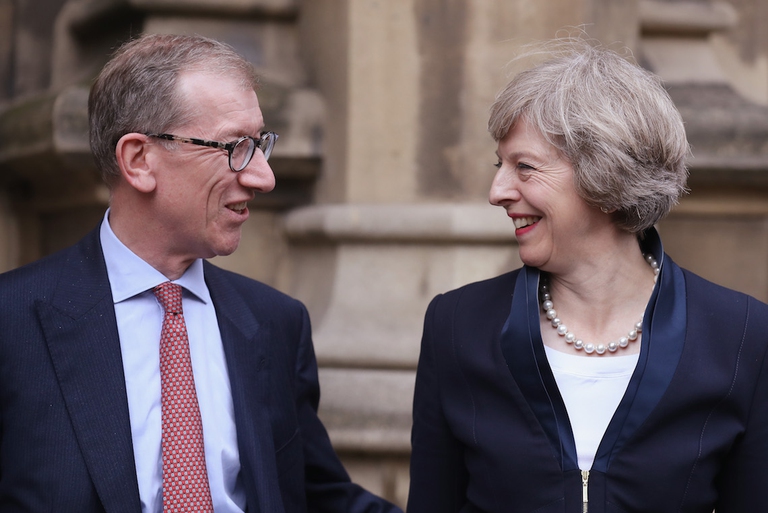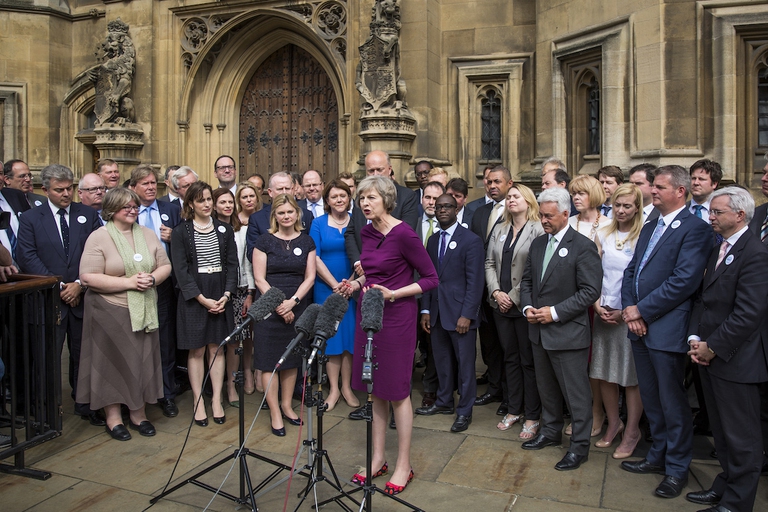
The Louise Michel is the humanitarian rescue ship saving lives in the Mediterranean. Financed by the artist Banksy, it has found a safe port in Sicily.
Theresa May will become the new Prime Minister of the United Kingdom on the 13th of July. The Brexit referendum and David Cameron’s resignation unleashed a leadership struggle in the ruling Conservative Party. First Boris Johnson, then Micheal Gove, then Andrea Leadsom: one by one Prime Minister-hopefuls withdrew their candidacies, clearing the field for May. The last to quit was
Theresa May will become the new Prime Minister of the United Kingdom on the 13th of July. The Brexit referendum and David Cameron’s resignation unleashed a leadership struggle in the ruling Conservative Party. First Boris Johnson, then Micheal Gove, then Andrea Leadsom: one by one Prime Minister-hopefuls withdrew their candidacies, clearing the field for May. The last to quit was Leadsom. Her decision followed outrage at her comments that, unlike the soon-to-be leader, she’s a mother and therefore has a “stake in the future of the UK” (because apparently, only mothers do).
‘Together, we will build a better Britain’ – watch Theresa’s speech after being chosen as @Conservatives leader: pic.twitter.com/MIUIqRVSoM
— Theresa May (@theresa_may) July 11, 2016
“She’s strong, competent, more than able to provide the leadership our country is going to need in the years ahead”. This is how Cameron endorsed May when on the 11th of July he announced she would succeed him. She’s the longest-serving home secretary, a role she has occupied since 2010, in half a century. She’s the most powerful female Conservative since Margaret Thatcher (to whom she is often compared). Yet, “she’s probably the most inscrutable new prime minister we’ve had for many decades,” according to Financial Times political commentator Janan Ganesh.
Born in Eastbourne, on the southeast coast of England in 1956, the daughter of a Church of England vicar, she attended Oxford University and graduated in Geography in 1977. There she met husband Philip May – according to reports, it was future Pakistani prime minister Benazir Bhutto who introduced them – who she’s been married to since 1980. They live together in Sonning-on-Thames, 60 kilometres west of London. The village is also home to celebrity couple George Clooney and Amal Alamuddin.
Before politics her career was in banking. She worked at the Bank of England shortly after graduating until 1983, then in the payments industry. Her hobbies are cooking and walking, which she says she’s able to pursue despite her struggle with diabetes.
She entered Parliament in 1997 as Conservative Party member for Maidenhead, a town west of London. In her over twenty years in the House of Commons she has taken on many different roles, including being Minister for Women & Equalities from 2010 to 2012. David Cameron chose her as home secretary when he was elected in 2010 and again at his re-election five year later.
Viewed as a liberal conservative, the issues she’s been most strongly associated with are immigration and terrorism. According to her website, her legacy has been to “free up the police to fight crime more effectively, secure the borders and reduce immigration, and protect the UK from terrorism”.
As member of parliament (MP) she has consistently voted for UK military intervention, including sending troops to Iraq, Afghanistan, Syria and Libya. She also supported the Investigatory Powers Bill, known as the Snooper’s Charter, aimed at contrasting terrorism by giving the government extensive powers to intercept and store communications data.
She also voted for: cutting welfare benefits (including for those unable to work due to disability or injury), strong enforcement of immigration rules and a stricter asylum system, raising university tuition fees, and same-sex marriage. Her environmental track record is rather disappointing and includes voting against measures to prevent climate change, stronger regulation of fracking and a hunting ban, and in favour of selling public forests.
#TheresaMay arrives at No10 ahead of Cameron’s last Cabinet meetinghttps://t.co/w0oC5GwvSm
— RT UK (@RTUKnews) July 12, 2016
She’s against strengthening human rights legislation, which in her view limits government powers. She has repeatedly spoken out against the Human Rights Act, voting for it to be repealed just this past May. Back in 2011 she came under fire for saying: “We all know the stories about the Human Rights Act … about the illegal immigrant who can’t be deported because he had a pet cat”. In response, senior judges specified that the fact the man owned a pet had nothing to do with the decision to let him stay in the UK.
As Home Secretary May has overseen a turn towards stricter, more hostile migration rules. For example, since April non-EU workers living in the UK for under ten years and earning less than 35,000 pounds (46,000 dollars) a year aren’t allowed to settle permanently. Under her watch the Home Office promulgated a controversial campaign in 2013 to encourage illegal migrants to hand themselves in to the police, judged by many to be racist. Posters were circulated on vans depicting handcuffs and the message: “In the UK illegally? Go home or face arrest”.
Lest we forget, the soon-to-be new UK prime minister sent out ‘Go Home’ vans deemed too extreme even by Nigel Farage pic.twitter.com/d2NqvPKL5g
— Mehdi Hasan (@mehdirhasan) July 11, 2016
She campaigned for the UK to remain in the European Union, and has at times opposed and at others supported deepening EU integration. She was also in favour of holding a referendum on EU membership. In response to her being announced as the nation’s new leader she said:
Brexit means Brexit and we’re going … to negotiate the best deal for Britain in leaving the EU … We need to unite our country. We need a strong, new, and positive vision for the future. A vision of a country that works not for the privileged few but works for every one of us.
Theresa May faces the grave task of picking up the pieces of Brexit, setting the course for one of the most significant changes in the country’s recent history. Yes she’s a seasoned politician, but her track record on immigration, human rights and the environment doesn’t bode well for a progressive and inclusive future. Let’s just hope she proves us wrong.
Siamo anche su WhatsApp. Segui il canale ufficiale LifeGate per restare aggiornata, aggiornato sulle ultime notizie e sulle nostre attività.
![]()
Quest'opera è distribuita con Licenza Creative Commons Attribuzione - Non commerciale - Non opere derivate 4.0 Internazionale.
The Louise Michel is the humanitarian rescue ship saving lives in the Mediterranean. Financed by the artist Banksy, it has found a safe port in Sicily.
Venezuelan refugees are vulnerable to the worsening outbreak in South America: while coronavirus doesn’t discriminate, it does affect some people more than others.
In the midst of India’s coronavirus lockdown, two dozen people lost their lives in a desperate bid to return home: migrant labourers forced to leave the cities where they worked once starvation began knocking at their doors.
Behrouz Boochani returned to being a free man during the course of this interview. The Kurdish writer was imprisoned by the Australian government in Papua New Guinea for six years.
The Global Compact for Safe, Orderly and Regular Migration was signed by 164 nations in Marrakech. This is what the non-binding agreement that encourages international cooperation stipulates.
The winners of the World Press Photo 2019 tell the stories of migrants in the Americas. From the iconic image of a girl crying on the border between Mexico and the United States to the thousands of people walking from Honduras towards a better life.
The Semìno project is a journey of discovery through different countries’ food habits, offering migrants employment opportunities and allowing us to enjoy the properties of vegetables from all over the world.
Travelling across the new route used by migrants to cross the Balkans and reach Trieste in Italy, a reportage that documents the social, economic and political changes of the countries along the way.
The countries hosting the most refugees aren’t the wealthy, Western ones. An overview by NGO Action Against Hunger reminds us that refugees and internally displaced people are far from being safe.









